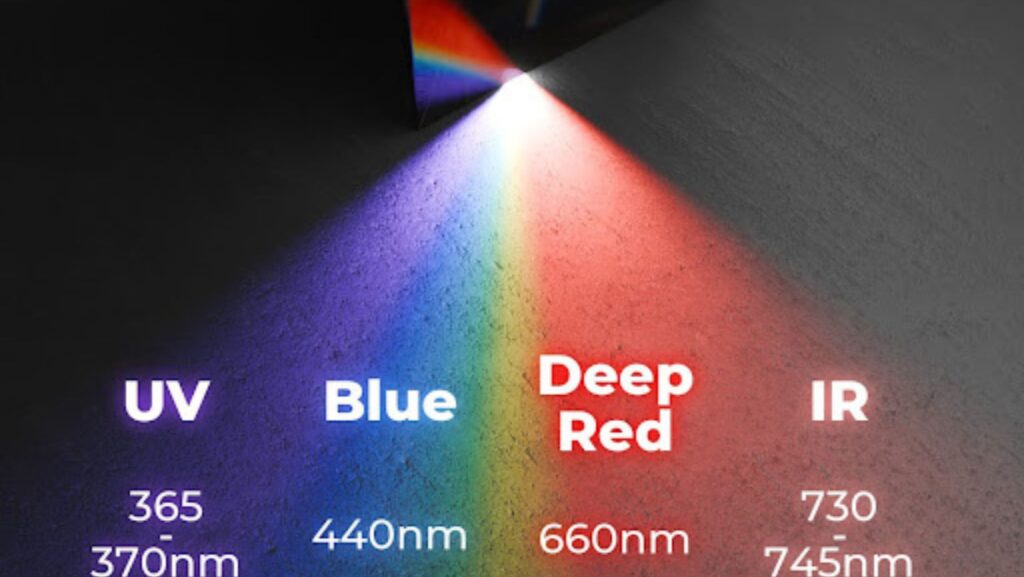Light plays an essential role in photosynthesis, where plants convert light energy into chemical energy to fuel their growth. Different wavelengths of light affect different plant processes. For example, blue light promotes vegetative growth, while red light encourages flowering and fruiting. 
However, there’s more to light than just the visible spectrum. UV and IR light, often overlooked, can provide added benefits that go beyond what regular grow lights can do. Let’s take a closer look at how these supplemental grow lights can upgrade your indoor garden.
UV Light
UV light, which is invisible to the human eye, is often broken down into UV-A and UV-B light. UV-A light helps plants by stimulating various growth processes, while UV-B light has been shown to produce certain beneficial effects in plants.
Enhancing Photosynthesis
UV light helps to increase the rate of photosynthesis in plants. This means that plants can produce more energy, resulting in faster growth and stronger plants.
Improving Disease Resistance
UV light can activate the production of protective compounds, such as antioxidants, in plants. These compounds can improve the plant’s ability to fight off pests and diseases, making your indoor garden more resilient.
Promoting Flowering and Fruit Production
Research shows that a small amount of UV light can enhance flowering and fruiting in plants. It helps trigger the production of plant hormones that play a role in the development of flowers and fruits, improving both yield and quality.
Enhancing Color and Aroma
Certain plants, like herbs and flowers, can develop more intense colors and stronger fragrances when exposed to UV light. This is particularly beneficial for gardeners looking to grow aromatic herbs or plants with vibrant blooms.
IR Light
Infrared light, while not directly contributing to photosynthesis, plays an important role in the growth process. It is primarily associated with heat, but the heat generated by IR light can be beneficial for indoor plants in certain situations.
Optimizing Photosynthesis Efficiency
IR light can help to regulate the temperature in the growing environment. Plants often grow more efficiently in a specific temperature range, and IR light can help maintain that balance, especially in cooler indoor environments. By adding a little extra warmth, plants can grow more effectively and absorb light more efficiently.
Encouraging Root Development
IR light promotes deeper penetration of light into the plant canopy, encouraging more robust root development. This is particularly helpful for plants that require strong root systems to thrive. It can also help plants establish themselves more quickly when transplanted.
Supporting Heat-Loving Plants
Certain plants, especially tropical species, thrive in warmer environments. By adding IR light to your setup, you can mimic the warmth of their native habitats, helping them grow faster and more vigorously.
Maximizing Your Yield
By ensuring that your plants get exposure to the full spectrum of light, you maximize their growth potential, leading to healthier, more productive plants. Whether you’re growing vegetables, herbs, or flowers, this combined lighting approach can result in higher yields and better-quality produce.
Choosing the Right Supplemental Grow Lights
When choosing supplemental UV and IR lights for your indoor garden, consider the following:
- Type of Plants: Some plants require more UV or IR light than others. For example, cannabis and certain flowering plants benefit greatly from UV light, while heat-loving tropical plants may thrive with additional IR light.
- Light Intensity: Both UV and IR lights need to be used in moderation. Too much UV light can damage plant tissues, and excessive IR light can overheat your plants. A balanced approach is key.
- Lighting Fixtures: Look for grow lights specifically designed to emit UV and IR light. These can be in the form of bulbs, strips, or integrated systems that provide a broad spectrum of light.
Final Thoughts
Supplemental grow lights, especially UV and IR, can elevate your indoor garden by enhancing the effectiveness of traditional grow lights. They promote plant health, boost resilience, and improve growth, flowering, and fruiting, offering a range of valuable benefits.



